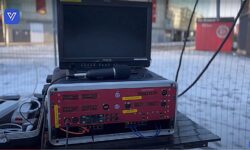Vislink’s TerraLink Encoder Provides Help With Remote Production
Story Highlights
In today’s media landscape, remote video production has become an essential part of bringing large events to life. In this article, Vislink will explore some of the hurdles that producers face and discuss potential solutions to achieve a successful remote video production.
Network Reliability
One of the most significant challenges in remote video production is ensuring a stable and reliable network connection. High-quality video streaming requires a robust internet connection capable of handling large amounts of data in real time. In large event settings, where multiple cameras, audio feeds and other equipment are involved, maintaining a stable network connection becomes crucial. Producers must work closely with network providers and invest in redundancy measures to minimize the risk of network failures or interruptions.
Latency and Synchronization
Another challenge with remote video production is managing latency and synchronization issues. In live events, it is essential for the video and audio to be in sync to provide a experience for viewers. However, when working remotely, different elements of the production, such as cameras, microphones, and control rooms, can introduce latency. This latency can disrupt the synchronization between audio and video, creating a disjointed experience. Producers must employ specialized tools and techniques to compensate for latency and ensure accurate synchronization throughout the production process.
Coordination and Communication
Producing a remote video production for large events involves coordination between numerous stakeholders, including camera operators, technicians, directors, and talent. Unlike traditional onsite productions, remote productions require precise communication and coordination to ensure everyone is on the same page. Establishing clear communication channels, utilizing project management tools, and conducting regular rehearsals can help mitigate potential coordination challenges. It is also important to have a dedicated team or coordinator who can oversee the entire production process and promptly address any issues that arise.
Technical Setup and Equipment
Setting up a remote video production requires an understanding of the technical requirements and having the right equipment. Producers must ensure that all cameras, microphones, encoders, and other essential components are properly configured and optimized for remote production. Additionally, remote production often involves deploying specialized remote-controlled cameras and robotic systems to capture different angles and perspectives. Adequate training for the production crew is crucial to maximize the performance of remote production equipment and minimize technical issues during the event.
Content Delivery and Viewer Experience:
Finally, delivering the produced content to viewers in a seamless and engaging manner poses its own set of challenges. Remote video productions often rely on streaming platforms and content delivery networks (CDNs) to reach audiences worldwide. Producers need to work closely with streaming providers to ensure high-quality video delivery, adaptive streaming capabilities, and global scalability. Optimizing the viewer experience by providing multiple camera angles, graphics, and interactive elements can further enhance the engagement level of remote event attendees.
Despite the challenges, remote video production for large events has become an indispensable tool in the event industry. Overcoming obstacles such as network reliability, latency, coordination, technical setup, and content delivery is essential for delivering a successful remote production. By leveraging advanced technologies, effective communication, and meticulous planning, producers can create immersive and engaging experiences for remote event attendees worldwide. As technology continues to evolve, remote video production will likely become even more seamless, offering exciting opportunities for the future of large-scale events.
With the introduction of Vislink’s TerraLink rackmount IP encoders
Specifically developed for remote production, those challenges can be overcome effectively and cost-effectively. The TerraLink line has been designed for professional OB and remote production live streaming applications and can be upgraded with bonded modems. It provides a condensed yet capable system that enables seamless remote production, delivering robust connectivity and advanced features for a superior live streaming experience.
The Vislink TerraLink encoder solution, based on Mobile Viewpoint technology, is a comprehensive remote production video return system that integrates with SNG trucks, Outside Broadcast Vans, and studio setups. It ensures reliable and low-latency live video streaming, allowing viewers to enjoy a smooth and uninterrupted viewing experience. With its robust connectivity, broadcasters can confidently deliver high-quality content from any location, whether a sports event, business convention, or other events.
Connectivity is a critical aspect of remote production, and the TerraLink encoders excel in this area. They offer versatile connection options, including Ethernet and wireless connectivity via Wi-Fi or SIM cards. This flexibility ensures a reliable and uninterrupted streaming experience, even in challenging network environments. In the event of a primary connection failure, the SIM connection automatically activates, providing a seamless transition without compromising the live stream.
With the TerraLink 4CM encoder, broadcasters have the power to create productions using multiple cameras. The encoder serves as a multi-camera remote production unit, effortlessly integrating with any broadcast camera. Equipped with four camera inputs and full duplex audio capabilities, it offers complete control over the production process. By manipulating video quality and bandwidth settings for each camera, broadcasters can optimize the visual experience, whether capturing fast-paced action or static shots.
The TerraLink encoders empower broadcasters with control and collaboration tools. Operators can fine-tune essential parameters such as shading and white balance while managing full duplex audio. On-screen talent can easily monitor the video return, ensuring they stay in sync with the production and can jump in effortlessly when needed. All encoders in the field can be remotely managed and controlled via LinkMatrix, a free-to-use management platform that operates from a browser on any device. This means non-technical journalists and production people in the field do not need to manage the units directly. LinkMatrix can manage individual encoders, destinations, show proxies, record and go, video return, transmission and cellular network status, and setups in an array of different configurations.
Its robust connectivity, compatibility with various setups, and advanced features provide broadcasters with the tools they need to streamline their remote production workflows. With the ability to handle multiple cameras, fine-tune video quality, and optimize collaboration, this encoder empowers broadcasters to deliver exceptional live video content.
